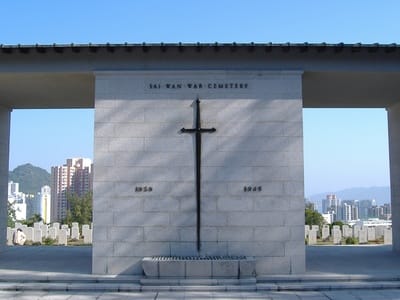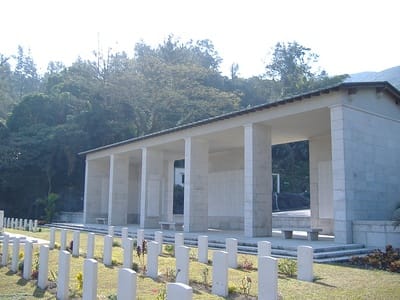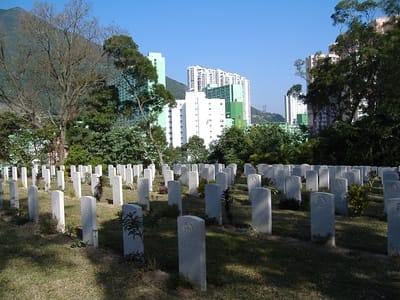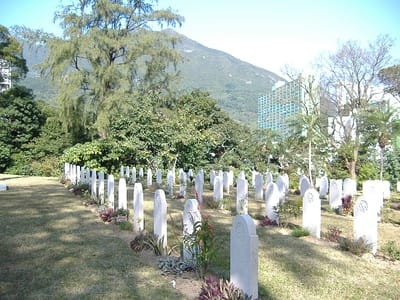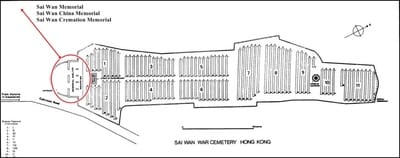SAI WAN WAR CEMETERY
Hong Kong
China
Location Information
Sai Wan War Cemetery is in the north-east of the island of Hong Kong, in the Chai Wan area, about 11 kilometres from the centre of Victoria.
At the entrance to the cemetery on Cape Collinson Road stands the memorial to those who died in Hong Kong and have no known grave. From it the cemetery slopes down towards the sea.
The cemetery is located on Cape Collinson Road, Chai Wan, Hong Kong Island. Take bus route No. 9 to Shek O from Shau Kei Wan bus terminal, adjacent to exit A3 of mass transit railway Shau Kei Wan station and alight at Cape Collinson bus stop beyond the roundabout on Shek O Road. Walk downwards along Cape Collinson for approximately 600 metres.
To travel to Sai Wan Cemetery from Stanley Military Cemetery take bus No. 14 to Grande Promenade outside the cemetery on Wong Ma Kok Road and alight at Shek O Road bus stop in front of the roundabout on the Tai Tam Road. Walk south into Shek O Road then turn left and walk downwards along Cape Collinson Road for approximately 600 metres.
The Cape Collinson area has many cemeteries. Walking up this narrow one way traffic road, one will pass the Catholic Cemetery situated on the hillside to the left of the road, and the Hong Kong Military Cemetery on the right. Sai Wan War Cemetery is about half way up Cape Collinson Road and faces the Muslim and Buddhist cemeteries.
Visiting Information
Sai Wan War Cemetery is open daily: 08:00 - 17:00.
The location or design of this site makes wheelchair access impossible.
Historical Information
The island of Hong Kong fell to the Japanese on Christmas Day 1941 following a brief but intense period of fighting. Most of those buried in this cemetery were killed at this time, or died later as internees or prisoners of war during the Japanese occupation. The remains of those who died as prisoners in Formosa (now Taiwan) were brought to Hong Kong for burial at Sai Wan in 1946.
There are now 1,505 Commonwealth casualties of the Second World War buried or commemorated at Sai Wan War Cemetery. 444 of the burials are unidentified. There are special memorials to 16 Second World War casualties buried in Kowloon (Ho Man Tin) No 3 Muslim Cemetery, whose graves were lost. There are also 77 war graves of other nationalities from this period, the majority of them Dutch and 7 non-world war graves that the Commission maintains on behalf of the MoD.
The cemetery contains special memorials to 12 First World War casualties buried in Kowloon (Ta Sek Ku) Mohammedan Cemetery, whose graves have since been lost.
At the entrance to the cemetery stands the SAI WAN MEMORIAL bearing the names of more than 2,000 Commonwealth servicemen who died in the Battle of Hong Kong or subsequently in captivity and who have no known grave. Additional panels to the memorial form the SAI WAN CREMATION MEMORIAL, bearing the names of 144 Second World War casualties whose remains were cremated in accordance with their faith, and the SAI WAN (CHINA) MEMORIAL, commemorating 72 casualties of both wars whose graves in mainland China could not be maintained.
Both the cemetery and memorial were designed by Colin St Clair Oakes.
Sai Wan War Cemetery is in the north-east of the island of Hong Kong, in the Chai Wan area, about 11 kilometres from the centre of Victoria.
At the entrance to the cemetery on Cape Collinson Road stands the memorial to those who died in Hong Kong and have no known grave. From it the cemetery slopes down towards the sea.
The cemetery is located on Cape Collinson Road, Chai Wan, Hong Kong Island. Take bus route No. 9 to Shek O from Shau Kei Wan bus terminal, adjacent to exit A3 of mass transit railway Shau Kei Wan station and alight at Cape Collinson bus stop beyond the roundabout on Shek O Road. Walk downwards along Cape Collinson for approximately 600 metres.
To travel to Sai Wan Cemetery from Stanley Military Cemetery take bus No. 14 to Grande Promenade outside the cemetery on Wong Ma Kok Road and alight at Shek O Road bus stop in front of the roundabout on the Tai Tam Road. Walk south into Shek O Road then turn left and walk downwards along Cape Collinson Road for approximately 600 metres.
The Cape Collinson area has many cemeteries. Walking up this narrow one way traffic road, one will pass the Catholic Cemetery situated on the hillside to the left of the road, and the Hong Kong Military Cemetery on the right. Sai Wan War Cemetery is about half way up Cape Collinson Road and faces the Muslim and Buddhist cemeteries.
Visiting Information
Sai Wan War Cemetery is open daily: 08:00 - 17:00.
The location or design of this site makes wheelchair access impossible.
Historical Information
The island of Hong Kong fell to the Japanese on Christmas Day 1941 following a brief but intense period of fighting. Most of those buried in this cemetery were killed at this time, or died later as internees or prisoners of war during the Japanese occupation. The remains of those who died as prisoners in Formosa (now Taiwan) were brought to Hong Kong for burial at Sai Wan in 1946.
There are now 1,505 Commonwealth casualties of the Second World War buried or commemorated at Sai Wan War Cemetery. 444 of the burials are unidentified. There are special memorials to 16 Second World War casualties buried in Kowloon (Ho Man Tin) No 3 Muslim Cemetery, whose graves were lost. There are also 77 war graves of other nationalities from this period, the majority of them Dutch and 7 non-world war graves that the Commission maintains on behalf of the MoD.
The cemetery contains special memorials to 12 First World War casualties buried in Kowloon (Ta Sek Ku) Mohammedan Cemetery, whose graves have since been lost.
At the entrance to the cemetery stands the SAI WAN MEMORIAL bearing the names of more than 2,000 Commonwealth servicemen who died in the Battle of Hong Kong or subsequently in captivity and who have no known grave. Additional panels to the memorial form the SAI WAN CREMATION MEMORIAL, bearing the names of 144 Second World War casualties whose remains were cremated in accordance with their faith, and the SAI WAN (CHINA) MEMORIAL, commemorating 72 casualties of both wars whose graves in mainland China could not be maintained.
Both the cemetery and memorial were designed by Colin St Clair Oakes.



